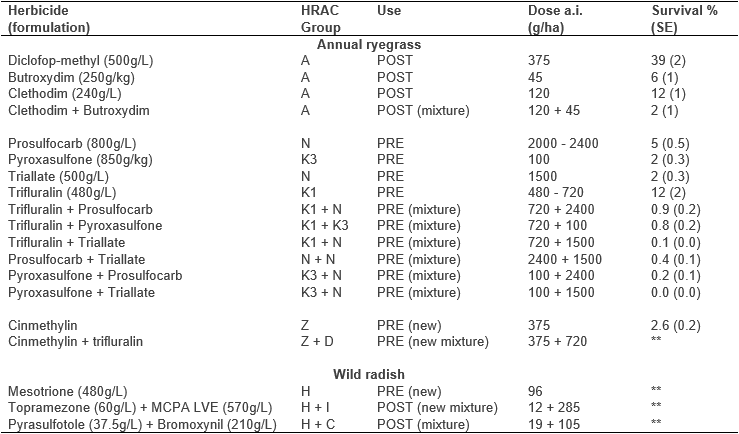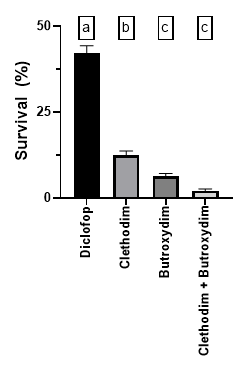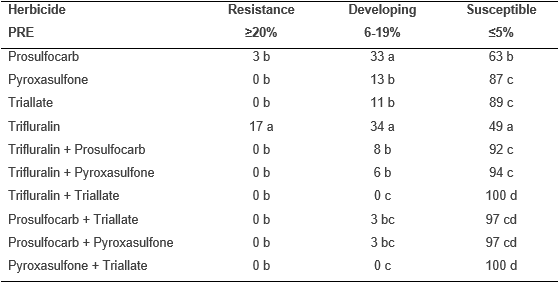What do we know of new herbicides for annual ryegrass and wild radish control?
What do we know of new herbicides for annual ryegrass and wild radish control?
Author: Roberto Busi, Australian Herbicide Resistance Initiative | Date: 10 Feb 2020
Key messages
- Herbicide resistance testing can provide useful information for weed control programs.
- Extensive herbicide resistance testing across 100+ weed populations shows two-way herbicide mixtures (at the highest recommended label rate) can provide highly effective weed control.
- A ‘mix and rotate’ strategy should be adopted by testing and deploying the most effective herbicide mixture.
- Herbicide mixtures are not a ‘silver bullet’ in weed control (…but surely a very difficult one to dodge).
Introduction
In Australia, herbicide resistance has increased in several major weed species such as annual ryegrass and wild radish. Single and multiple resistances have evolved to several modes-of-action in foliar post-emergent herbicides, which has compromised their efficacy. To control resistant annual ryegrass, grain growers have combined soil-applied pre-emergence herbicides with non-chemical weed control tools such as harvest weed-seed control. However, new cases of herbicide-resistant weeds continue to be reported, due to the overreliance on herbicides in current farming operations. For this reason, in the past few decades, new pre-emergence herbicides have been developed and commercialised in Australia but cases of field resistance even to these new herbicides have recently been reported. Herbicide mixtures have been shown to decrease the risk of resistance evolution, but they have rarely been tested on weed seed samples collected from problematic paddocks or in geographical surveys.
Aims
New herbicides to control annual ryegrass and wild radish will be available from 2020. This study reports on the latest knowledge of herbicide resistance in the two most damaging weeds infesting the Western Australian wheatbelt - annual ryegrass and wild radish. We aim to reinforce the benefits of proactively testing for herbicide resistance in major weed species with special emphasis on the adoption of herbicide mixtures to mitigate the spread of herbicide resistance and its subsequent impact on farm profitability. In 2018-2020 we screened about 140 annual ryegrass and 100 wild radish populations submitted to The University of Western Australia for comprehensive herbicide resistance testing. We report and discuss the observed efficacy of weed control, the frequency of resistance to old and new herbicides and the future of herbicide resistance with a special focus on herbicide mixtures.
Methods
Weed seed sample collection
Seed samples of annual ryegrass and wild radish were collected from cropped paddocks at different locations in the WA wheatbelt both before sowing and at harvest in 2018 and at harvest in 2019. Within each farm, samples were collected from paddocks chosen according to the resistance perceptions of the grower and/or their consultant. Weed seed was bulked to obtain one population per sampled paddock at the time of collection. Seeds were stored in dry conditions and prepared for herbicide testing. Herbicides were applied at the correct time either to the soil (PRE, pre-emergence herbicides) or to seedlings at the two-leaf stage (POST, post-emergence herbicides) at dosages indicated in Table 1. Plant survival was assessed 3-4 weeks after herbicide treatment.
About 140 annual ryegrass populations and 100 wild radish populations were treated with individual herbicides or herbicide mixtures either pre- or post-emergence during 2018–20 (Table 1). Mean values of plant survival and resistance frequency are either presented below or will be presented orally at the Grain Research Updates.
Data analyses
Populations were classified as susceptible if zero to 5% of plants survived the recommended dose on the label. Populations with resistant survivors were classified into two groups: those with ≥20% plant survival and those having <20% survival (this includes all plant survival between 6–19%). ANOVA was done on plant survival data expressed as a percentage and means were separated with Tukey’s test. Resistance frequencies were analysed by chi-square analysis.
Table 1. Herbicide products, formulations, Herbicide Resistance Action Committee (HRAC) classification, use (PRE, POST or mixtures) and dosages used to assess plant survival (%) in populations of annual ryegrass and wild radish collected in Western Australia in 2018-2019 from cropped paddocks.

** Data not shown in this manuscript but will be presented orally at the “Updates”.
Results
Annual ryegrass
Overall, there was 15% plant survival to the POST herbicides tested, which indicates substantial herbicide resistance in a large proportion of samples, whereas the mean survival to PRE-herbicides was only 2%, reflecting effective control of the majority of annual ryegrass field populations tested.
Post-emergence herbicides (POST)
As expected and reported in several random herbicide resistance surveys of annual ryegrass in Western Australia, resistance frequency to diclofop-methyl was high, with >90% samples tested classified as resistant with mean plant survival >40% observed in the samples tested (Figure 1). About 60% of the tested samples were clethodim-resistant and the overall frequencies of resistance and developing resistance were significantly lower than diclofop-methyl (Table 2). Overall, the mean survival observed across all tested samples was 12% (Figure 1). With butroxydim, there was a similar frequency of developing resistance but significantly lower frequency of resistant samples (Table 2). Similarly, the mean survival observed was 6%, which was statistically lower than the plant survival in response to clethodim (Figure 1). Survival to the mixture of clethodim + butroxydim was the lowest (approx. 2%) but not significantly lower than survival to butroxydim. Conversely, the proportion of samples classified as developing resistance or resistant in response to the mixture clethodim + butroxydim was significantly lower than in response to stand-alone application of either herbicide (Table 2).
Pre-emergence herbicides (PRE)
The mean survival to trifluralin was significantly greater than all other PRE-herbicide treatments tested and ranged widely from 0% up to about 90% in a few samples (Figure 2). Similarly, trifluralin resistance was found in >50% of the samples (Table 3). Survival to prosulfocarb was significantly lower than trifluralin, but greater than all other PRE-treatments expect for cinmethylin (Figure 2). There was a similar frequency of developing resistance to prosulfocarb and trifluralin, which was significantly higher than all other tested herbicides (Table 3). The observed mean plant survival to all other herbicide treatments was similarly low, including stand-alone and binary mixtures (Figure 2). There were no highly resistant samples to several PRE-herbicides except for prosulfocarb (3%) and trifluralin (17%) (Table 3). The frequency of developing resistance was similar in all other treatments except for the mixtures trifluralin + triallate and pyroxasulfone + triallate (Table 3). There were no samples found to be resistant to the two highly effective mixtures: trifluralin + triallate and pyroxasulfone + triallate (Table 3).
Wild radish
Low-level cross-resistance to the HPPD herbicides mesotrione, tembotrione and isoxaflutole has been recently reported in a field population of wild radish collected in WA (data not shown). In another study, repeated selection with a low dose of the herbicide Velocity (pyrasulfotole + bromoxynil) resulted in a low-level of cross-resistance to mesotrione. Two new HPPD herbicides (mesotrione and topramezone) are available from 2020 for the wheat-selective control of wild radish. In early 2020 we screened 100+ field-collected populations of wild radish with three HPPD herbicides (Table 1). Efficacy data will be presented to understand the current incidence of HPPD resistance in wild radish in WA before the start of the 2020 growing season.

Figure 1. A) Mean plant survival (%) observed across 140 field populations of annual ryegrass collected in Western Australia in 2018–2019 and tested for herbicide resistance at the recommended label dose to three POST ACCase stand-alone herbicides and a binary mixture. Different letters indicate significantly different mean values separated by multiple comparisons by a post-hoc Tukey test (P < 0.05).

Figure 2. Mean plant survival (%) observed across 140 field populations of annual ryegrass collected in Western Australia in 2018–2019 and tested for herbicide resistance at the recommended label dose to four PRE-standalone herbicides versus six binary mixtures of the same herbicides, vs two new herbicides. Different letters indicate significantly different mean values separated by multiple comparisons by a post-hoc Tukey test (P<0.05).
Table 2. Herbicide resistance frequencies of 140 populations of annual ryegrass collected in Western Australia in 2018-2019 and tested for herbicide resistance to POST ACCase herbicides and their mixtures. Tested samples were divided into three categories according to the percentage survival observed at the recommended label dose. Herbicide “Resistance” was diagnosed with ≥20 % survival, “Developing” resistance with survival ranging between 6-19% and “Susceptible” samples with survival ≤5%. Within each column, different letters indicate significantly different resistance frequencies (as proportions of samples resistant, developing or susceptible to each respective herbicide). Values were separated by multiple comparisons with a c2 heterogeneity test performed using the statistical software R with the command prop.test.

Table 3. Herbicide resistance frequencies of 140 populations of annual ryegrass collected in Western Australia in 2018-2019 and tested for herbicide resistance to PRE-herbicides and their mixtures. Tested samples were divided into three categories according to the percentage survival observed at the recommended label dose. Herbicide “Resistance” was diagnosed with ≥20 % survival, “Developing” resistance with survival ranging between 6-19% and “Susceptible” samples with survival ≤5%. Within each column, different letters indicate significantly different resistance frequencies (as proportions of samples resistant, developing or susceptible to each respective herbicide). Values were separated by multiple comparisons with a c2 heterogeneity test performed using the statistical software R with the command prop.test.

** Field samples with survival >6% to cinmethylin and experimental 2021 need further investigation, assessment of inheritance and data are not reported.
Conclusion
Annual ryegrass and wild radish can rapidly evolve multiple herbicide resistance. However, surprisingly, we did not find resistance to some herbicide mixtures in annual ryegrass. It appears that some herbicide mixtures have remained immune to resistance. By screening and testing large numbers of field populations of annual ryegrass and wild radish effective options for weed control can be identified and the results immediately conveyed to farmers and consultants. If effective herbicide mixtures of old and new herbicides are tested and deployed in fields infested by weeds that remain susceptible to them, then it is reasonable to believe that maximum weed control can be achieved, and the risk of herbicide resistance evolution drastically reduced.
Acknowledgements
Part of the data presented were obtained as part of a project funded by the GRDC [Project Number: UWA1803 - Focus farms fighting weed foes in the Kwinana West Port Zone]. The author would like to thank GRDC for their continued support. A special mention goes also to the GRDC West Team (Jo Wheeler, Elizabeth Von Perger and Curtis Liebeck) and the collaborators from the ConsultAg Team (Geoff Fosbery, Brad Joyce, Garren Knell, Trent Butcher, Ben Whisson) and to all growers and advisors involved including Trevor Syme, Dustyn Fry, Geoff Fisher, Gary Lang, Matt Panizza, Ryan Pearce, Derek Young, Scott Young, Russel Burgess and Kit Leake. The Australian Herbicide Resistance Initiative is a GRDC funded initiative in Australia (GRDC code: UWA 00171).
Contact details
Dr Roberto Busi
35 Stirling Hwy, Crawley, 6009 WA
08 6488 1423, 0415 185 553
roberto.busi@uwa.edu.au
@robbert115
